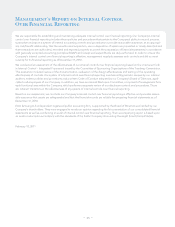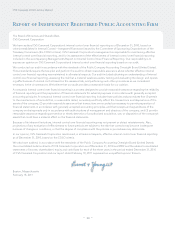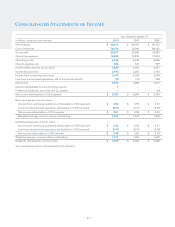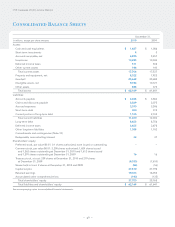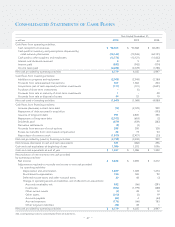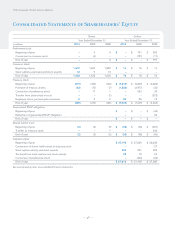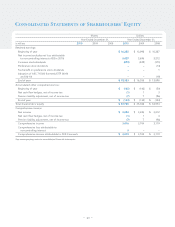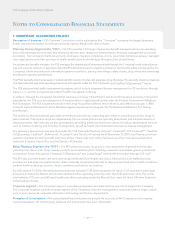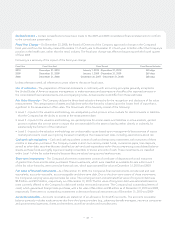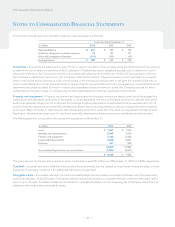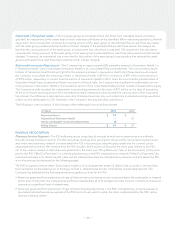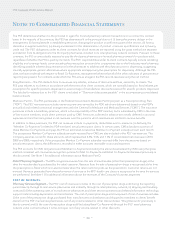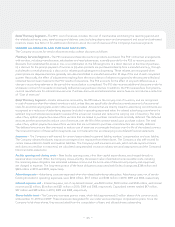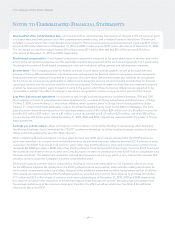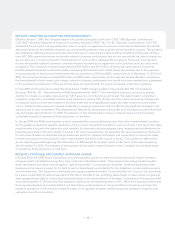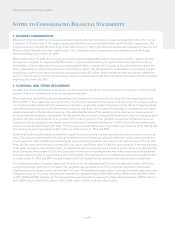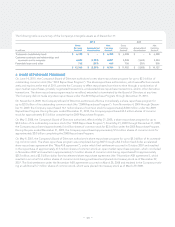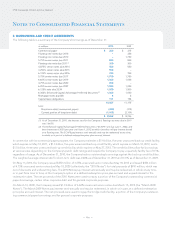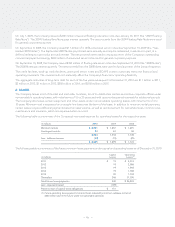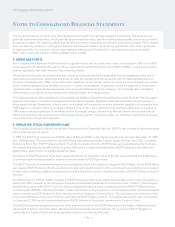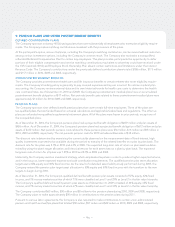CVS 2010 Annual Report Download - page 57
Download and view the complete annual report
Please find page 57 of the 2010 CVS annual report below. You can navigate through the pages in the report by either clicking on the pages listed below, or by using the keyword search tool below to find specific information within the annual report.
Impairment of long-lived assets – The Company groups and evaluates fixed and finite-lived intangible assets, excluding
goodwill, for impairment at the lowest level at which individual cash flows can be identified. When evaluating assets for potential
impairment, the Company first compares the carrying amount of the asset group to the estimated future cash flows associated
with the asset group (undiscounted and without interest charges). If the estimated future cash flows used in this analysis are
less than the carrying amount of the asset group, an impairment loss calculation is prepared. The impairment loss calculation
compares the carrying amount of the asset group to the asset group’s estimated future cash flows (discounted and with interest
charges). If required, an impairment loss is recorded for the portion of the asset group’s carrying value that exceeds the asset
group’s estimated future cash flows (discounted and with interest charges).
Redeemable noncontrolling interest – The Company has an approximately 60% ownership interest in Generation Health, Inc.
(“Generation Health”) and consolidates Generation Health in its consolidated financial statements. The noncontrolling share-
holders of Generation Health hold put rights for the remaining interest in Generation Health that if exercised would require
the Company to purchase the remaining interest in Generation Health in 2015 for a minimum of $27 million and a maximum
of $159 million, depending on certain financial metrics of Generation Health in 2014. Since the noncontrolling shareholders of
Generation Health have a redemption feature as a result of the put right, the Company has classified the redeemable noncon-
trolling interest in Generation Health in the mezzanine section of the consolidated balance sheet outside of shareholders’ equity.
The Company initially recorded the redeemable noncontrolling interest at a fair value of $37 million on the date of acquisition.
At the end of each reporting period, if the estimated accreted redemption value exceeds the carrying value of the noncontrol-
ling interest, the difference is recorded as a reduction of retained earnings. Any such reductions in retained earnings would also
reduce income attributable to CVS Caremark in the Company’s earnings per share calculations.
The following is a reconciliation of the changes in the redeemable noncontrolling interest:
in millions 2010 2009
Beginning balance $ 37 $ –
Acquisition of Generation Health – 37
Net loss attributable to noncontrolling interest (3) –
Ending balance $ 34 $ 37
REVENUE RECOGNITION:
Pharmacy Services Segment – The PSS sells prescription drugs directly through its mail service pharmacies and indirectly
through its retail pharmacy network. The PSS recognizes revenues from prescription drugs sold by its mail service pharmacies
and under retail pharmacy network contracts where the PSS is the principal using the gross method at the contract prices
negotiated with its clients. Net revenue from the PSS includes: (i) the portion of the price the client pays directly to the PSS,
net of any volume-related or other discounts paid back to the client (see “Drug Discounts” later in this document), (ii) the price
paid to the PSS (“Mail Co-Payments”) or a third party pharmacy in the PSS’ retail pharmacy network (“Retail Co-Payments”) by
individuals included in its clients’ benefit plans and (iii) administrative fees for retail pharmacy network contracts where the PSS
is not the principal as discussed on the following pages.
The PSS recognizes revenue when: (i) persuasive evidence of an arrangement exists, (ii) delivery has occurred or services have
been rendered, (iii) the seller’s price to the buyer is fixed or determinable and (iv) collectability is reasonably assured. The
Company has established the following revenue recognition policies for the PSS:
• Revenues generated from prescription drugs sold by mail service pharmacies are recognized when the prescription is shipped.
At the time of shipment, the Company has performed substantially all of its obligations under its client contracts and does not
experience a significant level of reshipments.
• Revenues generated from prescription drugs sold by third party pharmacies in the PSS’ retail pharmacy network and associ-
ated administrative fees are recognized at the PSS’ point-of-sale, which is when the claim is adjudicated by the PSS’ online
claims processing system.
– 53 –


